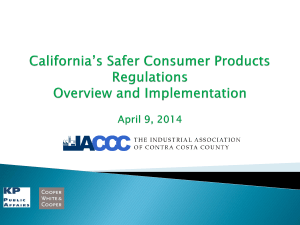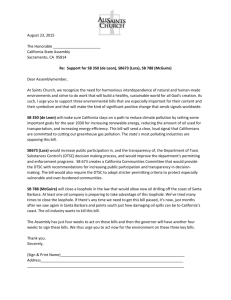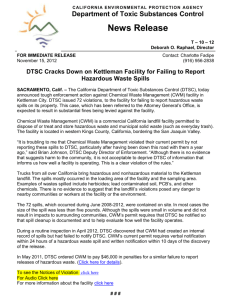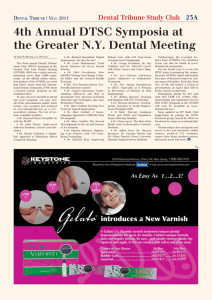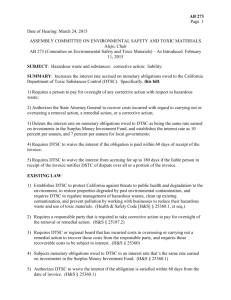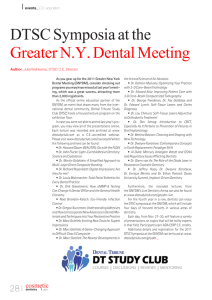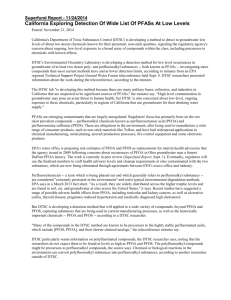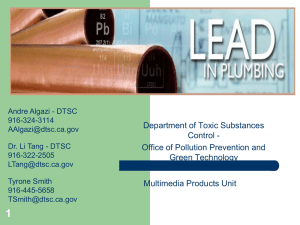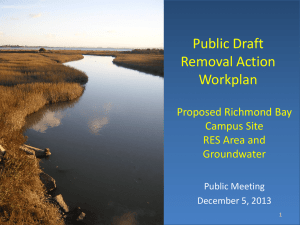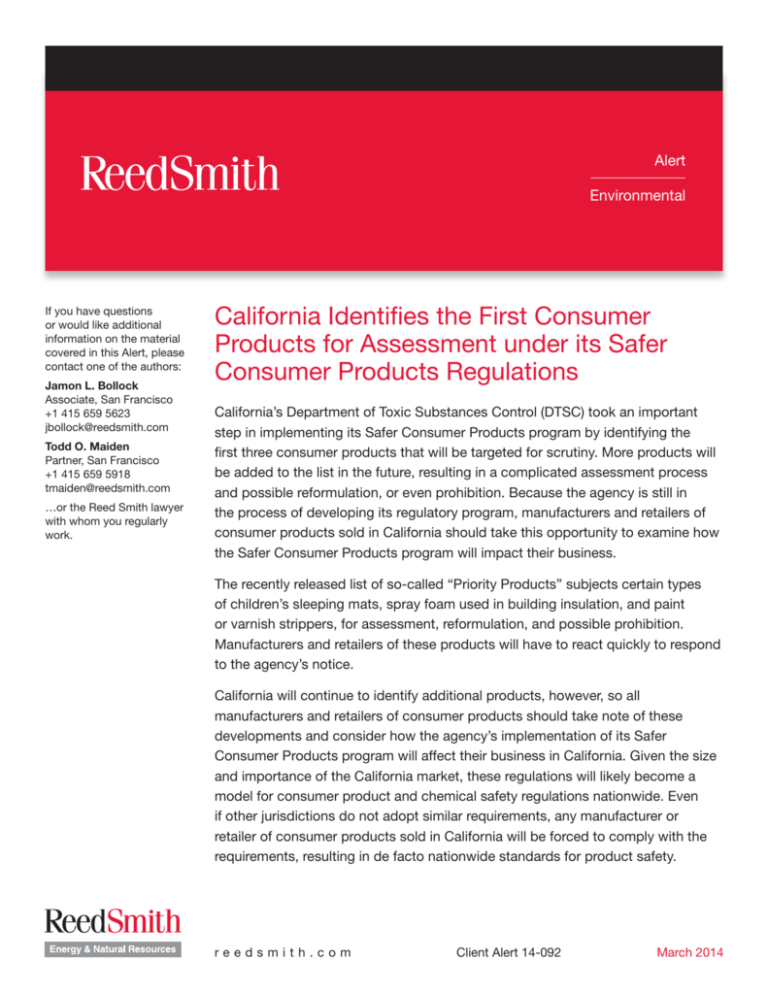
Alert
Environmental
If you have questions
or would like additional
information on the material
covered in this Alert, please
contact one of the authors:
Jamon L. Bollock
Associate, San Francisco
+1 415 659 5623
jbollock@reedsmith.com
Todd O. Maiden
Partner, San Francisco
+1 415 659 5918
tmaiden@reedsmith.com
…or the Reed Smith lawyer
with whom you regularly
work.
California Identifies the First Consumer
Products for Assessment under its Safer
Consumer Products Regulations
California’s Department of Toxic Substances Control (DTSC) took an important
step in implementing its Safer Consumer Products program by identifying the
first three consumer products that will be targeted for scrutiny. More products will
be added to the list in the future, resulting in a complicated assessment process
and possible reformulation, or even prohibition. Because the agency is still in
the process of developing its regulatory program, manufacturers and retailers of
consumer products sold in California should take this opportunity to examine how
the Safer Consumer Products program will impact their business.
The recently released list of so-called “Priority Products” subjects certain types
of children’s sleeping mats, spray foam used in building insulation, and paint
or varnish strippers, for assessment, reformulation, and possible prohibition.
Manufacturers and retailers of these products will have to react quickly to respond
to the agency’s notice.
California will continue to identify additional products, however, so all
manufacturers and retailers of consumer products should take note of these
developments and consider how the agency’s implementation of its Safer
Consumer Products program will affect their business in California. Given the size
and importance of the California market, these regulations will likely become a
model for consumer product and chemical safety regulations nationwide. Even
if other jurisdictions do not adopt similar requirements, any manufacturer or
retailer of consumer products sold in California will be forced to comply with the
requirements, resulting in de facto nationwide standards for product safety.
reedsmith.com
Client Alert 14-092
March 2014
Therefore, manufacturers and retailers of consumer products sold in California
should monitor the rulemaking process and consider assisting the agency in
developing a regulatory program that works.
Green Chemistry in California California’s Green Chemistry program has been
in development since the state legislature passed enabling legislation in 2008. The
final version of the regulations, known formally as the Safer Consumer Products
regulations, became effective in October 2013 after several years of rulemaking
and multiple versions of proposed regulations.
The overall goal of the Green Chemistry program is to encourage the design of
safer products and, in doing so, reduce or eliminate the use of toxic chemicals
and the generation of hazardous substances. The focus is on environmental
protection at the design stage of the production process, rather than at the
disposal stage.
Instead of banning the use of certain chemicals without knowing the availability
or safety of alternatives, the regulations provide a process for manufacturers to
answer two questions: Is a chemical necessary? Is there a safer alternative?
Safer Consumer Product Regulations To accomplish the goals of the Green
Chemistry program, DTSC’s Safer Consumer Products (SCP) regulations set forth
a multi-stage process that will be implemented over the next several years.
The first step in the regulatory process, after the final
regulations were adopted in October, was to establish
a list of “Candidate Chemicals.” It is based on existing
authoritative lists of chemicals of concern, including the
Proposition 65 list, and contains about 1,100 chemicals.
Chemicals on the list are those that exhibit at least one of
seven hazard traits – (1) carcinogenicity, (2) reproductive
toxicity, (3) mutagenicity, (4) developmental toxicity,
(5) endocrine disruption, (6) neurotoxicity, and/or
(7) persistent bioaccumulative toxicity – or are on “exposure
indicator lists” for water quality, air quality, or biomonitoring.
Some of the chemicals on the Candidate Chemicals list
have already been banned in the European Union.
Source: DTSC
The list of Candidate Chemicals is available at the DTSC website.
Priority Products As the second step in the regulatory process, DTSC has
identified its initial list of three proposed Priority Products – consumer products
that contain at least one Candidate Chemical for which there is a significant risk
of human or environmental exposure. Selection is based on a combination of the
nature and extent of use, exposure, and potential harm posed.
reedsmith.com
Client Alert 14-092
March 2014
The three Priority Products selected by DTSC are:
1. Children’s foam padded sleeping products, such as nap mats with
polyurethane foam, that contain a flame retardant chemical called tris
phosphate or TDCPP.
2. Spray polyurethane foam containing unreacted diisocyanates, an insulation
product that can cause severe asthma for installers and do-it-yourselfers when
it is still wet.
3. Paint and varnish strippers and surface cleaners with methylene chloride, used
to remove old paint and varnish. Methylene chloride is linked to cancer and
many other health problems.
According to DTSC, these three products were selected as Priority Products
based on two criteria in the SCP regulations: (1) the products have the potential
to expose people or the environment to one or more Candidate Chemicals; and
(2) this exposure has the potential to “contribute to or
cause significant or widespread adverse impacts.”
These three products are only proposed as Priority
Products. DTSC will conduct three public workshops in
May and June, and at the end of this year will then begin
the rulemaking process, which the agency acknowledges
will take up to a year to complete.
After the rulemaking process to add these three products
as Priority Products, DTSC will then begin the process
of adding additional Priority Products. As with these first
three, the next set of proposed Priority Products will have
to go through the rulemaking process before they are
formally added as Priority Products and are subjected to
additional requirements. Regulators expect to add threeto-five new Priority Products each year, subject to the
rulemaking process.
Industry analysts predict that the next set of Priority
Products may include nail polish that contains toluene,
carpet adhesive with formaldehyde, and fluorescent
lights that contain mercury. The next categories of Priority
Products are to be released in October 2014.
Source: DTSC
Alternatives Assessments for Priority Products DTSC has been careful to
clarify that the selection of a product as a Priority Product is not a ban. Rather,
a Priority Product is subject to additional scrutiny and compared with potential
alternatives, including chemical substitution and product redesign.
reedsmith.com
Client Alert 14-092
March 2014
Once the Priority Products list is finalized, companies that manufacture, import,
or sell a Priority Product will have 60 days to notify DTSC of its status as a
“responsible entity,” and 180 days to develop and submit to DTSC a preliminary
“Alternatives Analysis” report. The primary responsibility
for compliance belongs to the manufacturers of a product.
Retailers will only be responsible for undertaking an
Alternatives Analysis if no manufacturer or importer is
available.
Source: DTSC
In the Alternatives Analysis report, responsible entities
must evaluate different ways of making the product to
limit exposure to the chemical of concern. An Alternatives
Analysis may consider reducing or eliminating the chemical from the product
entirely, using an alternative chemical, or possibly constructing or formulating the
product in a different way so that, even if the chemical is still used, the exposure
risk to consumers and the environment is reduced. After DTSC approves a
preliminary Alternatives Analysis report, responsible entities will have one year to
develop and submit a final report.
Because an Alternatives Analysis report will likely contain valuable trade secret
information about how the products are made and about the availability or viability
of any potential reformulations, this disclosure requirement raises a variety of
questions regarding what companies must disclose, what they can withhold, and
what the government will do to safeguard trade secret information.
Regulatory Response Once DTSC has received the final Alternatives Analysis
report, it will use that information to require implementation of “regulatory
responses,” which could include requiring notice to
consumers, mandating alternative designs or reformulation,
restricting the use of a product, or simply banning sales of the
product in California altogether.
Next Steps for Priority Products DTSC will hold a series of
three public workshops in May and June 2014 to engage
in a dialogue with the public and with companies that
manufacture, distribute, or sell any of the Priority Products.
DTSC then expects to initiate rulemaking to codify the initial
Priority Products list in regulations in the latter part of 2014, a
process that may take up to one year.
After the list of Priority Products is finalized, a responsible
entity will have to begin the process of preparing an
Alternatives Assessment report. This process is expected to
be long and complicated – and potentially very expensive.
Source: DTSC
reedsmith.com
Client Alert 14-092
March 2014
If you are concerned that your products may be proposed as Priority Products in
the future, DTSC is expected to issue additional guidance this autumn. DTSC is
required to issue a Priority Product Work Plan by October 1 that will identify and
describe the product categories that the agency will evaluate to select Priority
Products for the following three years (2015 to 2017). DTSC will hold a separate
workshop in summer 2014 to discuss developing its Work Plan.
What Should Manufacturers and Retailers Do? All manufacturers and retailers
of consumer products in California, even those that do not make or sell any of the
three proposed Priority Products, should pay attention the regulatory process as it
unfolds.
Because this is the first time DTSC will assess Priority Products under the new
SCP regulations, many standards are likely to be established that will affect
products added to DTSC’s list later. For example, DTSC will decide important
issues involving the use of analytical test methods, required quality-assurance/
quality-control measures, cumulative impacts analysis, and threshold levels for
triggering compliance obligations. Manufacturers will have a critical opportunity to
work with DTSC at this early stage in the process to develop standards that will
work.
For companies that make or sell the proposed Priority Products, it is important to
note that the primary responsibility for compliance rests with the manufacturers of
the Priority Products. But if a manufacturer fails to fulfill its regulatory obligations,
compliance duties move down the supply chain to importers, then assemblers,
and finally to retailers. At this time, DTSC has not indicated that these parties will
receive any additional time to comply if a manufacturer misses the initial reporting
deadline. Therefore, all companies that distribute or sell consumer products in
California should use the coming months to determine whether they are involved
with any of the initially identified Priority Products, and should scrutinize the next
product categories when they are identified later this year.
Developing an action plan now, before a product is on a final Priority Product list,
could save a company substantial financial resources.
How Reed Smith Can Help Reed Smith’s environmental attorneys have decades
of collective experience advising clients in complying with regulations relevant to
consumer products, manufacturing, and hazardous substances. Our substantial
experience working with manufacturers and retailers in California and across
the country provides insight into how California’s Safer Consumer Products
regulations will affect their operations. Consequently, our team of skilled attorneys
can provide top-quality advice on submitting comments on these rulemaking
activities and complying with the Safer Consumer Products regulations when a
product is selected for additional assessment.
reedsmith.com
Client Alert 14-092
March 2014
Resources:
• DTSC’s Green Chemistry Program and Safer Consumer Products Regulations:
https://dtsc.ca.gov/SCP/index.cfm
• Candidate Chemicals List: https://dtsc.ca.gov/SCP/ChemList.cfm
• Alternatives Analysis Process: https://dtsc.ca.gov/SCP/AA.cfm
This Alert is presented for
informational purposes only
and is not intended to
constitute legal advice.
© Reed Smith LLP 2014.
All rights reserved. For
additional information, visit
http://www.reedsmith.com/legal/
reedsmith.com
NEW YORK
LONDON
HONG KONG
CHICAGO
WASHINGTON, D.C.
BEIJING
Client Alert 14-092
PARIS
LOS ANGELES
SAN FRANCISCO
PHILADELPHIA
March 2014
SHANGHAI
PITTSBURGH
HOUSTON SINGAPORE MUNICH ABU DHABI PRINCETON N. VIRGINIA WILMINGTON SILICON VALLEY DUBAI CENTURY CITY RICHMOND GREECE KAZAKHSTAN

